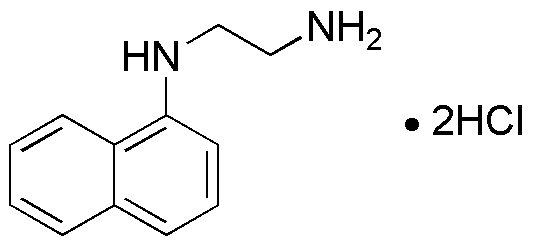N-(1-Naphthyl)ethylenediamine dihydrochloride is widely utilized in research focused on:
- Analytical Chemistry: This compound serves as a reagent in colorimetric assays, helping researchers detect and quantify various substances through color changes, which is essential in environmental and pharmaceutical analysis.
- Biochemistry: It is used in the study of enzyme kinetics and protein interactions, providing insights into biological processes and aiding in drug development.
- Material Science: The compound is employed in synthesizing organic semiconductors, contributing to advancements in electronics and optoelectronic devices.
- Pharmaceutical Industry: It plays a role in developing new therapeutic agents, particularly in the synthesis of compounds with potential anti-cancer properties.
- Colorimetric Sensors: This chemical is utilized in creating sensitive sensors for detecting heavy metals in water, offering a practical solution for environmental monitoring.
General Information
Properties
Safety and Regulations
Applications
N-(1-Naphthyl)ethylenediamine dihydrochloride is widely utilized in research focused on:
- Analytical Chemistry: This compound serves as a reagent in colorimetric assays, helping researchers detect and quantify various substances through color changes, which is essential in environmental and pharmaceutical analysis.
- Biochemistry: It is used in the study of enzyme kinetics and protein interactions, providing insights into biological processes and aiding in drug development.
- Material Science: The compound is employed in synthesizing organic semiconductors, contributing to advancements in electronics and optoelectronic devices.
- Pharmaceutical Industry: It plays a role in developing new therapeutic agents, particularly in the synthesis of compounds with potential anti-cancer properties.
- Colorimetric Sensors: This chemical is utilized in creating sensitive sensors for detecting heavy metals in water, offering a practical solution for environmental monitoring.
Documents
Safety Data Sheets (SDS)
The SDS provides comprehensive safety information on handling, storage, and disposal of the product.
Product Specification (PS)
The PS provides a comprehensive breakdown of the product’s properties, including chemical composition, physical state, purity, and storage requirements. It also details acceptable quality ranges and the product's intended applications.
Certificates of Analysis (COA)
Search for Certificates of Analysis (COA) by entering the products Lot Number. Lot and Batch Numbers can be found on a product’s label following the words ‘Lot’ or ‘Batch’.
*Catalog Number
*Lot Number
Certificates Of Origin (COO)
This COO confirms the country where the product was manufactured, and also details the materials and components used in it and whether it is derived from natural, synthetic, or other specific sources. This certificate may be required for customs, trade, and regulatory compliance.
*Catalog Number
*Lot Number
Safety Data Sheets (SDS)
The SDS provides comprehensive safety information on handling, storage, and disposal of the product.
DownloadProduct Specification (PS)
The PS provides a comprehensive breakdown of the product’s properties, including chemical composition, physical state, purity, and storage requirements. It also details acceptable quality ranges and the product's intended applications.
DownloadCertificates of Analysis (COA)
Search for Certificates of Analysis (COA) by entering the products Lot Number. Lot and Batch Numbers can be found on a product’s label following the words ‘Lot’ or ‘Batch’.
*Catalog Number
*Lot Number
Certificates Of Origin (COO)
This COO confirms the country where the product was manufactured, and also details the materials and components used in it and whether it is derived from natural, synthetic, or other specific sources. This certificate may be required for customs, trade, and regulatory compliance.


